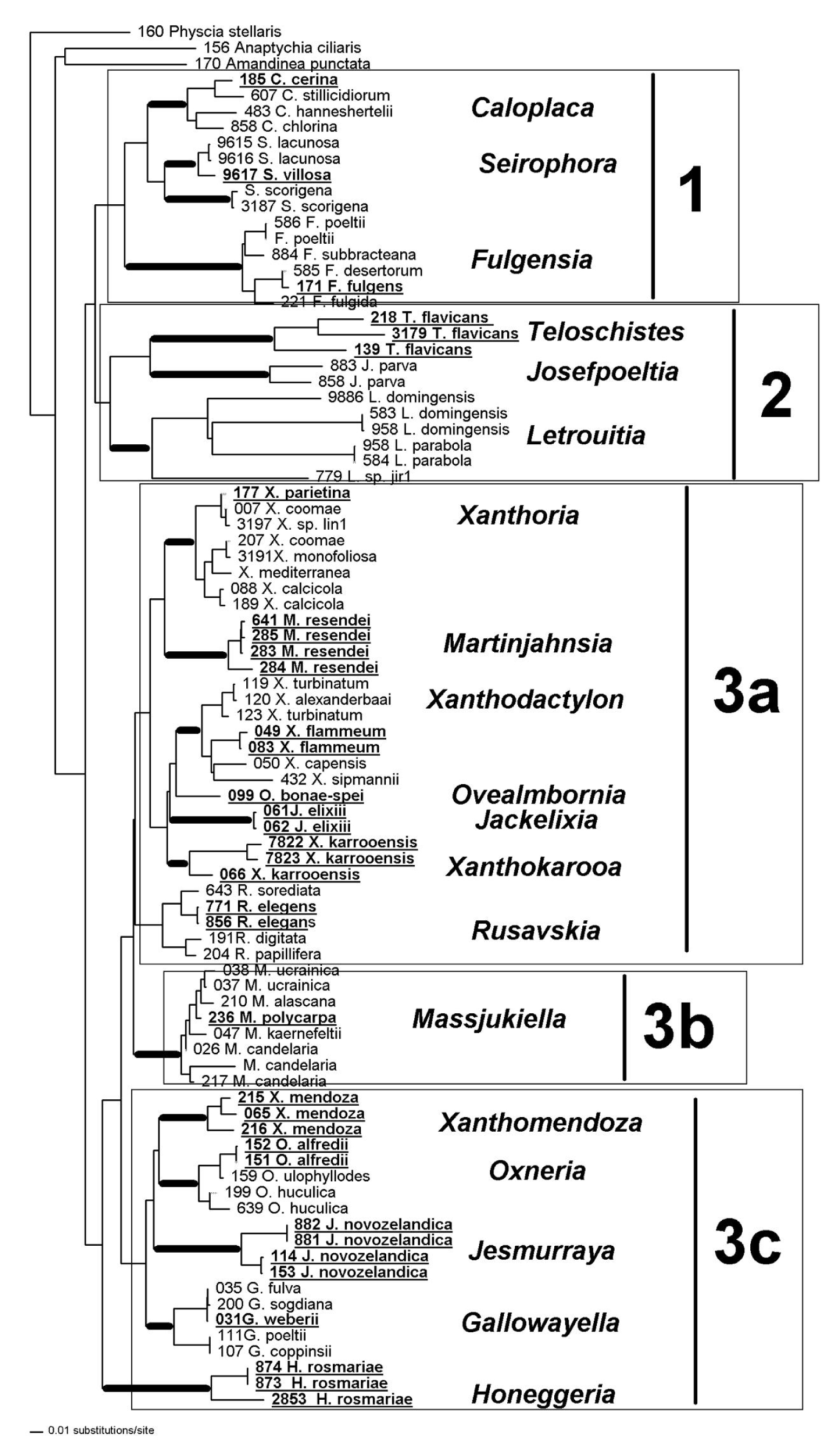Phylogeny and taxonomy of the Teloschistaceae (Ascomycota): Importance of monophyletic groups
Abstract
The molecular phylogeny of the Parmeliaceae, Physciaceae, Caliciaceae and many other families of lichen-forming fungi is now based on polyphasic approach using up to six or seven different genes of nuclear and mitochondrial DNA. As a consequence the taxonomy of the Parmeliaceae and other families can now be based on segregation of robust monophyletic groups of species. The majority of phylogenetic analyses of small species groups of the Teloschistaceae (especially of Caloplaca) are based on ITS1/ITS2 sequences of nuclear DNA as the main molecular tool. There are fewer reports of polyphasic molecular data having been used in such phylogenetic analyses (Gaya 2003, 2008; Fedorenko 2009, 2012). Such investigations have indicated that the currently accepted genera Caloplaca, Fulgensia, Xanthoria and Teloschistes are polyphyletic and the delineation of Caloplaca and Xanthoria and of Caloplaca and Fulgensia is problematic. The existence of well defined monophyletic groups within species groups like those of Caloplaca cerina, C. saxicola, C. regalis, C. ferruginea, C. variabilis and Fulgensia fulgens (some of which are type species of different genera proposed in ‘premolecular time’) are found to be distributed among other monophyletic branches of the xanthorioid lichens following analysis of nuclear molecular data. As a consequence generic names proposed for the above species groups (i.e. Blastenia, Pyrenodesmia, Polycauliona etc.) can be used together with Caloplaca s.str., Teloschistes, Seirophora and Fulgensia. However, it should be emphasized that following molecular analysis such groups/genera as Blastenia, Pyrenodesmia and the Caloplaca saxicola- group include far fewer species than was proposed from morphological segregation in the ‘premolecular’ period. Alternatively, molecular data confirms that the morphologically defined groups (i.e. Blastenia, Pyrenodesmia, Polycauliona etc.) are just as polyphyletic as the genera Teloschistes, Seirophora and Fulgensia. Caloplaca subgenus Gasparrinia is similarly polyphyletic. Furthermore, there have been recent proposals to retain the xanthorioid genera Jackelixia, Ovealmbornia, Xanthokarooa within Xanthoria. However, this is in complete disagreement with the presently accepted molecular phylogenetic tree of the Teloschistaceae. Molecular data indicates that Jackelixia, Ovealmbornia and Xanthokarooa could be considered to belong to Xanthodactylon s.l., but certainly not Xanthoria s.l. Further, present molecular data does not support the families Letrouitiaceae and Teloschistaceae. In future we will probably have three families, i.e. Teloschistaceae s. emend., Caloplacaceae s. emend. and Xanthoriaceae s. emend., instead of the two mentioned above. Special attention to monophyletic groups in the current Teloschistaceae as well as wider usage of a polyphasic molecular approach will also help to clarify the position and circumscription of generic groups within these families.
References
Fedorenko N.M., Stenroos S., Thell A., Kärnefelt I., Elix J.A., Hur J.–S., Kondratyuk S.Y. 2012. Molecular phylogeny of xanthorioid lichens (Teloschistaceae, Ascomycota), with notes on their morphology. In: Kärnefelt I., Seaward M.R.D., Thell A. (eds). Systematics, biodiversity and ecology of lichens. Bibliotheca Lichenologica 108: 58–76. J. Cramer in der Gebrüder Borntraeger Verlagsbuchhandlung, Stuttgart.
Gaya E., Lutzoni F., Zoller S., Navarro–Rosinés P. 2003. Phylogenetic study of Fulgensia and allied Caloplaca and Xanthoria species (Teloschistaceae, lichenforming Ascomycota). American Journal of Botany 90: 1095–1103.
Gaya E., Lutzoni F., Llimona X., Navarro–Rosinés P. 2008. Phylogenetic reassessment of the Teloschistaceae (lichen‑forming Ascomycota, Lecanoromycetes). Mycological Research 112: 528–546.
Lumbsch H.T., Ahti T., Kondratyuk S. et al. 2011. One hundred new species of lichenized fungi: a signature of undiscovered global diversity. Phytotaxa 18: 1–127.
Wirth V. & Kondratyuk S.Y. 2010. Neue Arten der Flechtenfamilie Teloschistaceae aus der Manibwuste und der Sukkulenten-Karoo (SW Afrika). Herzogia 23 (2): 1–16


This work is licensed under a Creative Commons Attribution-NonCommercial-NoDerivatives 4.0 International License.
The journal is licensed by Creative Commons under BY-NC-ND license. You are welcome and free to share (copy and redistribute the material in any medium or format) all the published materials. You may not use the material for commercial purposes. You must give appropriate credit to all published materials.
The journal allow the author(s) to hold the copyrights and to retain publishing rights without any restrictions. This is also indicated at the bottom of each article.





